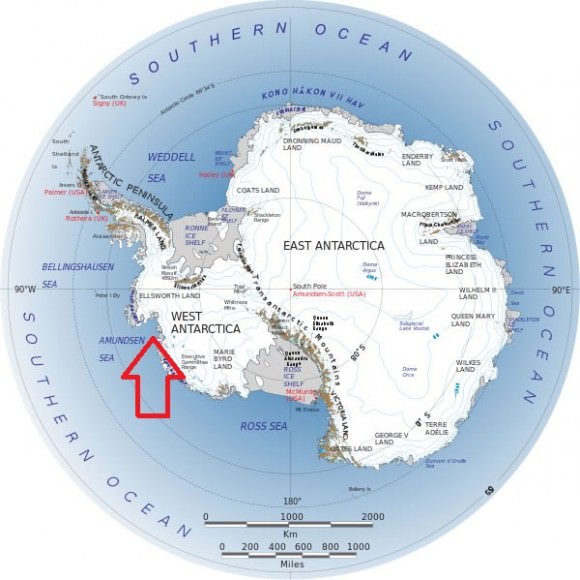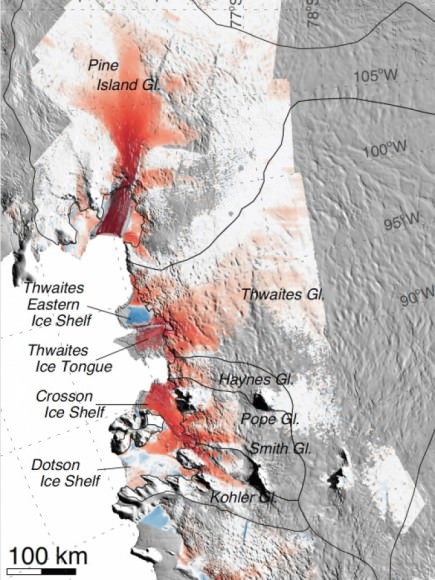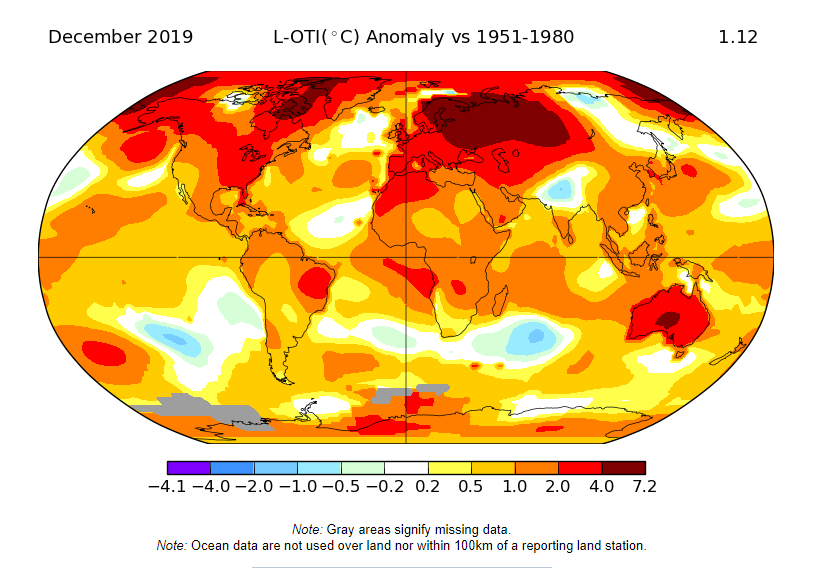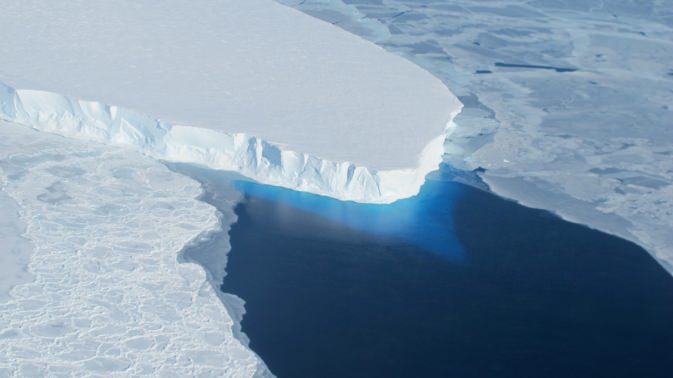NASA and the NOAA just announced that 2019 was the second hottest year on record. It barely edged out 2016, the previous warmest year. And both 2019 and 2016 are part of the global warming trend: the last five years have been the warmest five years on record. And the last decade was the warmest decade.
Continue reading “According to NASA, 2019 Was the Second Hottest Year on Record”NASA West Antarctic Ice Sheet Findings: Glacier Loss Appears Unstoppable
It’s a key piece of the climate change puzzle. For years, researchers have been eyeing the stability of the Western Antarctic Ice Sheet as global temperatures rise. Melting of the ice sheet could have dire consequences for sea level rise.
And though not unexpected, news from today’s NASA press conference delivered by Tom Wagner, a cryosphere program scientist with the Earth Science Division of NASA’s Science Mission Directorate in Washington D.C., Sridhar Anandakrishnan, a professor of geosciences at Pennsylvania University, and Eric Rignot, JPL glaciologist and professor of Earth system science at the University of California Irvine was certainly troubling.

The Western Antarctic Ice Sheet is a marine-based ice sheet below sea level that is bounded by the Ronne and Ross Ice Shelf and contains glaciers that drain into the Amundsen Sea. The study announced today incorporates 40 years of data citing multiple lines of observational evidence measuring movement and thickness of Antarctic ice sheets. A key factor to this loss is a thinning along the grounding line of the glaciers from underneath. The grounding line for an ice sheet is the crucial boundary where ice becomes detached from ground underneath and stretches out to become free floating. A slow degradation of the Western Antarctic Ice Sheet has been observed, one that can be attributed to increased stratospheric circulation along with the advection of ocean heat coupled with anthropogenic global warming.

“This sector will be a major contributor to sea level rise in the decades and centuries to come,” Rignot said in today’s press release. “A conservative estimate is it would take several centuries for all of the ice to flow into the sea.”
Thickness contributes to the driving stress of a glacier. Accelerating flow speeds stretch these glaciers out, reducing their weight and lifting them off of the bedrock below in a continuous feedback process.
A key concern for years has been the possible collapse of western Antarctica’s glaciers, leading to a drastic acceleration in sea-level rise worldwide. Such a catastrophic glacial retreat would dump millions of tons of ice into the sea over a relatively short span of time. And while it’s true that ice calves off of the Western Antarctic ice sheet every summer, the annual overall rate is increasing.
The study is backed up by satellite, airborne and ground observations looking at thickness of ice layers over decades.
Researchers stated that the Amundsen Sea Embayment sector alone contains enough ice to increase global sea level by 1.2 metres. A strengthening of wind circulation around the South Pole region since the 1980s has accelerated this process, along with the loss of ozone. This circulation also makes the process more complex than similar types of ice loss seen in Greenland in the Arctic.
The research paper, titled Widespread, rapid grounding line retreat of Pine Island, Thwaites, Smith and Kohler glaciers, West Antarctica from 1992 to 2011 has been accepted for publication in the American Geophysical Union’s journal Geophysical Research Letters. The American Association for the Advancement of Science will also be releasing a related study on the instability of the West Antarctic ice sheet today in the journal Science.
The most spectacular retreat referenced in the study was seen occurring at the Smith/Kohler glaciers, which migrated about 35 kilometres and became ungrounded over a 500 kilometre square region during the span of 1992 to 2011.
Another telling factor cited in the study was the large scale synchronous ungrounding of several glaciers, suggesting a common trigger mechanism — such as ocean heat flux — is at play.
On the ice shelf proper, the key points that anchor or pin the glaciers to the bedrock below are swiftly vanishing, further destabilizing the ice in the region.
Assets that were used in the study included interferometry data from the Earth Remote Sensing (ERS-1/2) satellites’ InSAR (Interferormetry Synthetic Aperture Radar) instruments, ground team observations and data collected from NASA’s Operation IceBridge overflights of the Antarctic. IceBridge uses a converted U.S. Navy P-3 Orion submarine hunting aircraft equipped with radar experiment packages used to take measurements of the thickness of the ice sheet.
Possible follow up studies targeting the region are upcoming, including five Earth science and observation missions scheduled to be launched this year, which include the Soil Moisture and Passive (SMAP) mission, The Orbiting Carbon Observatory (OCO-2) and the Global Precipitation Measurement (GPM) Core Observatory, launched this past February.
Along with these future NASA missions, there are also two missions — RapidScat and the Cloud-Aerosol Transport System or CATS — slated to study climate headed for the International Space Station this year.
This comes as recent United Nations and United States reports have also announced the reality of climate change and anthropogenic global warming.
“The collapse of this sector of West Antarctica appears to be unstoppable,” Rignot said. “The fact that the retreat is happening simultaneously over a large sector suggests it was triggered by a common cause, such as an increase in the amount of ocean heat beneath the floating sections of the glaciers.”
Of course, the solar cycle, volcanic activity, global dimming (via changes in reflectivity, known as albedo) and human activity all play a role in the riddle that is climate change. The bad news is, taking only natural factors into account, we should be in a cooling period right now.
And yes, reflective ice cover also plays a role in the albedo of the Earth, but researchers told Universe Today that no significant overall seasonal variations in the extent of surface layer of ice will change, as the key loss comes from the ungrounding of ice from below. Thus, this ice loss does not present a significant contribution to changes in overall global albedo, though of course, much of this additional moisture will eventually be available for circulation in the atmosphere. And the same was noted in the press conference for those pinning their hopes on the 2014 ice extent being greater than previous years, a season that was a mere blip on the overall trend. The change and retreat in the grounding line below seen in the study was irrespective of the ice extent above.
NASA’s Operation IceBridge will continue to monitor the ice flow when the next Antarctic deployment cycle resumes in October of this year.
And in the meantime, the true discussion is turning to the challenges of living with a warmer planet. Insurance companies, the Department of Defense and residents of low-lying coastal regions such as Miami’s South Beach already know that the reality of global warming and sea level rise is here. Perhaps the very fact that naysayers have at least backed up their positions a bit in recent years from “global warming isn’t happening” to “Its happening, but there are natural cycles” can at least give us a starting point for true intelligent science-based dialogue to begin.
– Social media questions from today’s conference can be reviewed at the #AskNASA hastag.


